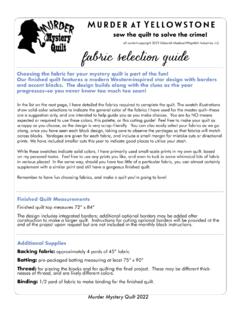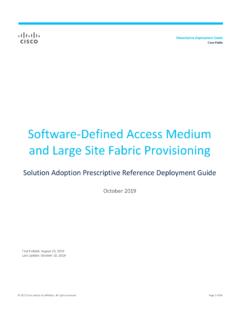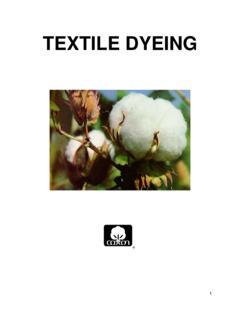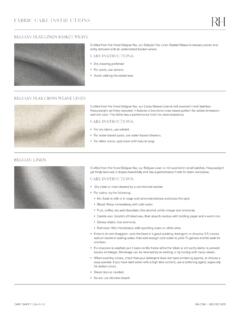Transcription of Chapter 3 Fabric properties and their characteristics ...
1 Jai Shri Ram1 Chapter 3 Fabric properties AND their CHARACTERISTICSP raburaj properties and their influence on product and desirable properties for that influence Fabric factors influencing Fabric factors influencing Fabric and human body structure and their influence and their effect on multi-layer fabrics and their composition and their effect on sportswear of Fabric composition in fibres and their effect on Fabric and smart fibres used in Shri INTRODUCTIONA confident understanding of Fabric behaviour and characteristics are vital in the design anddevelopment of a functional garment. For instance, a warp knit mesh Fabric made of 100%polyester designed to wick moisture away from the skin, with the quick dry ability, making itideal for everyday wear and preferred in extreme performance requirements.
2 On the other hand,Georgette is a balanced plain-woven Fabric generally made of 100% polyester with high twistyarns giving the Fabric less smooth appearance used in fashion apparel. Textile materials haveevolved in recent times and fabrics play a significant role in the development of sportswearindustry. In fact, it reflects the quality of a brand and its identity. The primary focus of thischapter is to present the essential and the desirable properties suitable for performance apparelespecially for sportswear. Various sportswear applications are discussed to enable the readerto understand the rationale for such parameter. Generally, garments intended for fashionapparel will have to fulfil the following characteristics : durability, strength, colourfastness,aesthetics and so forth.
3 These properties are mandatory for everyday use and maintenance forfashion apparel. However, in the case of performance apparel the requirements are functionaland application-specific properties , such as moisture transmission, thermal resistance, wicking,water proof, and flame resistant. The reason for requirements of such properties is becausefunctional apparel are subjected to a wide range of end uses such that a garment will be affectedby internal (fibres, yarn fineness, warp/weft movement, Fabric density, thickness, Fabric count)and external factors (external environment exposure to sunlight, wind, rain, cold weatherconditions and during use). These factors affect the performance and behaviour of functionalapparel which are discussed in the sections with examples.
4 In addition, the interaction betweenthe human body and garment is significant; this is true for those close-fit garments such as,base layer garments, where thermo-regulation plays a vital role in the performance of anathlete. Fabrics for sportswear are either woven or knitted and is often blended with syntheticJai Shri Ram3and natural fibres with varying linear density to provide an optimum performance. The heavyweight fabrics for outerwear are multi-layered (coated or laminated) and their properties differfrom light weight fabrics. Parameters of these fabrics due to structural difference arehighlighted here with specific focus on functional apparel.
5 Fabric behaviour will be affectedby its composition and this is presented with examples. This Chapter will empower the readerto understand the properties of fabrics for various performance application, and how theseparameters will affect the overall performance of the Fabric properties AND their INFLUENCE ON PRODUCTPERFORMANCEA number of fabrics are used in performance and sportswear apparel include smartfabrics which has intelligent approach to high body or ambient temperature the warmerthe material gets the faster the moisture management system functions Burlington ssmart Fabric temperature management. The technology uses micro-encapsulated phasechange materials called Thermocules to absorb and release heat to enhance weight, stretchable and soft waterproof or breathable fabrics; fabrics made of finemicro-fibres with breathability; soft shell or three layer fabrics which are bonded as wellas laminated made of tricot warp knits or woven Fabric for wind insulation or water proof;knits with synthetic or natural fibre blends and up to 30% elastane fibres for stretch andrecovery, fleece and brushed knit made of synthetic fibres that has a natural feel, stretchyand smooth surface; woven shirts with varying Fabric weight (160 to 400 g/m2).
6 Eco-friendly fabrics include recycled polyester; fancy fabrics with patterns, designs andfinishes, laser or etched burnt out, 3D knits, honey comb patterns and work wear andprotective wear fabrics include durable rugged finish, cut resistant, flame retardant,resistance to abrasion, reflective facings, etc. Figure 1 illustrates the type of fabrics usedJai Shri Ram4for fashion apparel which include woven, knitted fabrics, braids, interlining, bondedfabrics and felt. It should be noted that fabrics woven and knitted will performdifferently due to their structural variation which is summarised in Table 1. Functionalapparel have a combination of fabrics made of woven and knitted to suit 1: Common Fabric types for apparel end useTable 1: Fabric characteristicsKnitted fabricsWoven fabrics Series of interconnected loops made withone or more sets of yarns.
7 Can be ravelled from top to bottom. Warp knits cannot ravel. Fabric can snag and run, bowed orskewed. Usually heavier because more yarn isused. Two or more sets of yarns interlacedto form the Fabric structure. Yarns interlace at right angles. May be bowed or skewed. Can beravelled from any cut edge. Usually lighter in weight because lessyarn is used Possess stretch and elasticity, adapts tobody movement. Good recovery from wrinkles, airpermeable. Possess open spaces between yarns andbulky. Possess limited stretch andadaptability to body movement Bulkiness and recovery from wrinkledepends on weave structure Stable to stress, less air permeable,especially with dense Fabric .
8 Porous and less opaque Provides maximum hiding power andcoverJai Shri Ram5 Less stable in use and care. Highershrinkage unless heat-set More stable in use and care. Mayshrink less than 2%In order to understand the Fabric properties of garments designed for active wear it isnecessary to explore the sports trend - type of sports preferred, frequency of activities,and garments frequently purchased. In the UK, a number of sporting activities arepreferred, amongst many, swimming, running, cycling, tennis, golf and aerobics arewidely preferred (Mintel, 2011). Population involved in sports are generally youngergroup whose age range from 16 to 24 and this trend can noted across various , population in the age range 25 to 34 and 35 to 44 were also active particularlyin swimming, using gym, running, cycling and 2: Number of adults taking part in sports 2005/6 and 2013/14(Source: )There is a gradual and consistent increase in the number of people who involve in sportingactivities over the last eight years (Figure 2).
9 This includes adults who take part once amonth, once a week, twice and three times a Shri Ram6 Figure 3: Top five sports played(Source: )Sport England survey on the most frequently preferred sports in the UK reported thatswimming was mostly preferred to stay fit and as a sporting activity (Figure 3), followedby athletics, football, cycling and golf ( ). In this Chapter , specificfocus will be given to those fabrics which are used in the manufacture of garments forthese sport Shri Ram7 Figure 4: Sports clothing purchased during 2010/11in the UK(Source: Mintel, 2011)It can be noted that most of sport loving population purchase garments for casual end usesor as fashion apparel than for sporting activities.
10 This trend was observed across all formsof garments from trainers to fleece. It should be noted that survey was based on internetusers (n=2000) who were above 16 years and among them trainers, jogging trousers, t-shirts, shorts, football shirts, sweat shirts and sports jackets are popular amongconsumers. In addition, at the lower end of the segment, replica rugby shirts, waterproofjackets, fleece, leggings and vests were also popular (Figure 4). Mintel (2011) recently inits report stated that 33% of consumers purchased sportswear as a comfortable leisurewear; 21% consumers stated they would prefer branded sportswear and 46% of consumerspurchased sportswear clothing to stay physically active and to enhance their finding is interesting that the sportswear market has a good base, particularly amongyounger age group and most prefer garments to stay fit and support in their Shri Ram8It is also necessary to note that sports active adults prefer functional garments for Essential and desirable properties of fabricsA Fabric property is a characteristic of a material, which it should possess for it to be usedin a desired application satisfactorily.











